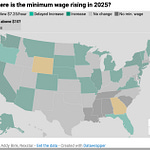This post goes out to both free and paid subscribers, but if you are not already a paid subscriber and value this effort and our growing community, please consider upgrading to a paid membership. Thanks in advance for your financial support of my work —it’s what allows me to keep researching and writing!

”The U.S. Interior Department on Friday [April 19, 2024] essentially rejected the Alaska Industrial Development and Export Authority’s proposal to build the Ambler Road, a 211-mile industrial road that would have cut through Gates of the Arctic National Park and Preserve to access copper and zinc deposits in Northwest Alaska…the Biden administration said the road, also known as the Ambler Access Project, would cause irreparable damage to wildlife including caribou, which many local people rely on for food. The administration also announced stronger protections for 13 million acres inside the National Petroleum Reserve-Alaska, a vast swath of oil-rich — but environmentally sensitive — federal land in the Arctic.” 1 Alaska Public Media/PBS, NPR April 19, 2024
Why has our country decided to “preserve” certain lands and bodies of water, to set aside and protect great swaths of our country, limit human access and use, and allow nature to dominate? It was, unsurprisingly, painters and poets who first discussed the idea of preserving large areas of land in the west for national parks. According to the National Park Service (NPS) page titled: “The Philosophical Underpinnings of the National Park Idea”, the portraiture artist, George Catlin, was the first to talk about the idea of large western national parks in 1832:
On a trip to the Dakotas Catlin worried about the impact of America's westward expansion on Indian civilization, wildlife and wilderness. They might be preserved, he wrote, "by some great protecting policy of government . . . in a magnificent park . . . A nation's park, containing man and beast, in all the wild and freshness of their nature's beauty!"
The “philosophical underpinnings” articulated by the NPS involve the idea that humans want and need contact with nature, especially as our country was becoming more urbanized. That the beauty of our forests, mountains, rivers and streams must be protected for current and future generations — there was increasing awareness even in the 1800’s and early 20th century that this natural beauty would be destroyed if industry was allowed unrestricted access to what was then still wilderness.
Beginning in 1806, developers bought land adjacent to Niagara Falls for industrial and tourism purposes. By 1860, the famous falls were so congested with haphazard development that the area had become the prime example of how a scenic wonder should not be developed.
And the preserved ecosystems, including wildlife, trees, plants and insects, in addition to the appreciation for the unspoiled scenery, could be used for education–part of the enjoyment of visiting a national park is learning — about our common heritage, and the reasons, both philosophical and practical, why we have chosen preservation over destruction as a nation.
Wallace Stegner, prolific writer, historian and chronicler of the American West said about our national park system in 1983:
National parks are the best idea we ever had. Absolutely American, absolutely democratic, they reflect us at our best rather than our worst.
Stegner also wrote “The Wilderness Letter”, described as a “personal manifesto” on why our country, as a collective whole, must preserve wilderness to preserve our collective sanity. It is essential reading if you want to understand why our government chose to step up and preserve and protect our natural wonders for the public.
The “idea” of national parks would not have made it out of our poetry and paintings, however, without Congress taking action. The first national park in the U.S. (and in fact the world’s first national park) is the magnificent YellowStone, sprawling across 2.2 million acres in Idaho, Montana and Wyoming. President Grant signed the Yellowstone National Park Protection Act into law on March 1, 1872, which not only established Yellowstone, but began the long process to create protected areas across the country, and the government agencies to oversee them.2
Here is a quick summary of our federally protected lands:
— The National Park Service, established in 1916, manages more than 429 national parks, including national monuments and battlefields, over approximately 85 million acres in all 50 states, D. C. and U.S. territories. The NPS is part of the Department of the Interior.
— The National Wildlife Refuge System was established in 1903 by President Theodore Roosevelt when he created the Pelican Island National Wildlife Refuge in Florida. Today there are 571 national wildlife refuges over 95 million land acres and 760 million marine acres in all 50 states. This system also includes over 1000 “National Wild and Scenic River” designations, and is administered by the U.S. Fish and Wildlife Service, which is also part of the Department of the Interior.
— The U.S. Forest Service was established in 1905 and is part of the U.S. Department of Agriculture. The Forest Service manages 154 national forests and 20 grasslands over 193 million acres of land.
— Wilderness Areas are designated by Congress and managed by the The National Wilderness Preservation System (NWPS) consisting of four federal agencies: National Park Service, Bureau of Land Management, US Fish and Wildlife Service, and US Forest Service, and include more than 800 wilderness areas over 111 million acres of land and water in 44 states.

I wrote about the history of Earth Day in a 2022 post, and like the history of our protected lands and waters, it took over a century for enough of our elected officials and citizens to care about our environment and choose modest preservation over destruction. But with the climate crisis actually here, what do we do now?
____________________________________________
I’d love to hear your thoughts on environmental issues. Are we doing enough to confront climate change? What about land and water protection? Should we continue to protect our pristine lands and waters from development? Feel free to leave your ideas in the Comment Section below.
What is interesting about this proposed industrial road project is that the company behind the project, Ambler Metals, LLC , has not applied for the permits to allow the actual mining — the road is intended as a first step for the project. What if the company started building the road, destroying pristine lands and waters in the process, and decided to abandon the project or was denied the mining permit? See: https://www.nytimes.com/2024/04/16/climate/ambler-road-alaska-interior.html The mining company also has formed a “non-profit”, in this case, a propaganda arm, ambleraccess.org, to promote both the industrial road and the mining project. Man, do they have a good PR team!
This is a summary from the Department of Interior of the various types of protected lands our government manages: https://www.doi.gov/blog/americas-public-lands-explained













Share this post